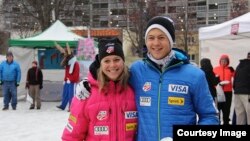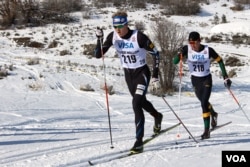MAZAMA, WASHINGTON —
A sibling teammate is one advantage a handful of athletes have at the Olympic games.
This year, U.S. figure skating just nominated the sister-and-brother ice dancing team of Maia and Alex Shibutani to the Sochi squad.
At Vancouver 2010, Austrian brothers Andreas and Wolfgang Linger took gold in the doubles luge ahead of Latvian siblings Andris and Juris Sics.
A brother-sister cross country ski duo from Washington State is hoping to join the Olympic sibling tradition. One has a ticket to the Winter Games, while the other still hopes to clinch a spot.
Competitive streak
Erik and Sadie Bjornsen grew up in a close knit family near the remote hamlet of Mazama, Washington. An enviable 200 km Nordic trail system starts practically at their doorstep. Their mother, Mary Bjornsen, says all three of her children had an athletic upbringing with constant friendly competition.
"I can remember people wondering when Erik was going to start beating Sadie," Mary said. "It took a while actually. Sadie was fast."
"Everything was a competition from running to the car, the first one there," Sadie said. "Or balancing at the [their father's] job site on a beam as long as you could."
Sadie and Erik tried to make the U.S. Olympic team four years ago but came up short. This year their chances look better. Based on her performance in recent competitions, Sadie, 24, has mathematically clinched a spot on the team.
Erik, her 22-year-old brother, is waiting to hear if his good results at the recent U.S. National Championships will earn him a spot, too.
Erik says both he and his sister really want to go to the Olympics together.
"It would just be nice. I think I can post better results when she is around cheering for me," he said. "I feel more comfortable just on the road with her. If I ever have any problems, there is someone I can go to."
"As a sibling you always have a little more of an open connection," Sadie said. "It's easy to get feedback from a sibling and not be threatened. Erik has been awesome for that because he has encouragement when I need it and also a reminder when I need it."
Olympic dreams
Sadie remembers being 8 or 9 years old when her Olympic dream took root.
She recalls a welcome home parade after the 1998 Nagano Games for another local Olympic cross country skier.
"I remember distinctly Laura McCabe riding in on a fire truck, the whole valley lining the streets and clapping," she said. "That was the moment. It was like, 'This is so neat.' It's such an honor. I knew I was going to be an Olympian."
The celebrated Olympic skier would eventually become the Bjornsen's next door neighbor. Another former Olympian and mentor, Leslie Thompson Hall, also moved onto the same rural street.
Sibling success
Hall says siblings make it to the Olympics more often than you might think.
"You know, certainly once someone is involved in a sport it is easy to have another kid in the family join the sport, too," Hall said. "To have two exceptional athletes is not that unusual."
U.S. Olympic medalists Phil and Steve Mahre in skiing and speedskaters Eric and Beth Heiden are earlier examples of sibling success at the Winter Games (1980 and 1984 Olympics).
This year, Canada has a triple threat with three sisters—Chloe, Justine and Maxime Dufour-Lapointe—competing in freestyle moguls.
Two Latvian brothers—Martins and Tomass Dukurs—are medal favorites in the face-first sledding event called skeleton.
The Swedish and U.S. hockey teams are also replete with siblings.
Prepping future athletes
This generation of siblings is already grooming the next. Olympic hopeful Erik Bjornsen recently took a day off from training to coach and inspire junior racers from his home valley.
He would normally have help from his big sister, Sadie, to lead this annual clinic. But she's on the World Cup ski racing circuit in Europe. So he demonstrates cross country racing techniques and finishing lunges by himself.
A class full of 8 to 13 year olds mimics his every move. Later, many say they want to follow in the Bjornsens' path.
"I've always wanted to go to the Olympics as well, yeah," said Emerson Worrell, who is in seventh grade. "It's really cool."
The U.S. expects to finalize its team roster for the Sochi games later this month.
This year, U.S. figure skating just nominated the sister-and-brother ice dancing team of Maia and Alex Shibutani to the Sochi squad.
At Vancouver 2010, Austrian brothers Andreas and Wolfgang Linger took gold in the doubles luge ahead of Latvian siblings Andris and Juris Sics.
A brother-sister cross country ski duo from Washington State is hoping to join the Olympic sibling tradition. One has a ticket to the Winter Games, while the other still hopes to clinch a spot.
Sibling Olympic Athletes
Sibling Olympic Athletes
- Canada's Chloe, Justine and Maxime Dufour-Lapointe hope to compete in skiing in Sochi
- Ice dancing team Maia and Alex Shibutani are competing for the US in Sochi
- Latvia's Martins and Tomass Dukurs are competing in the skeleton in Sochi
- Austrians Andreas and Wolfgang Linger won gold in doubles luge in Vancouver 2010
- Latvia's Andris and Juris Sics won silver in doubles luge in Vancouver 2010
- Twins Phil and Steve Mahre of the US medaled in skiing in 1980 & 1984
- Eric and Beth Heiden of the US medaled in speed skating in 1980 & 1984
Erik and Sadie Bjornsen grew up in a close knit family near the remote hamlet of Mazama, Washington. An enviable 200 km Nordic trail system starts practically at their doorstep. Their mother, Mary Bjornsen, says all three of her children had an athletic upbringing with constant friendly competition.
"I can remember people wondering when Erik was going to start beating Sadie," Mary said. "It took a while actually. Sadie was fast."
"Everything was a competition from running to the car, the first one there," Sadie said. "Or balancing at the [their father's] job site on a beam as long as you could."
Sadie and Erik tried to make the U.S. Olympic team four years ago but came up short. This year their chances look better. Based on her performance in recent competitions, Sadie, 24, has mathematically clinched a spot on the team.
Erik, her 22-year-old brother, is waiting to hear if his good results at the recent U.S. National Championships will earn him a spot, too.
Erik says both he and his sister really want to go to the Olympics together.
"It would just be nice. I think I can post better results when she is around cheering for me," he said. "I feel more comfortable just on the road with her. If I ever have any problems, there is someone I can go to."
"As a sibling you always have a little more of an open connection," Sadie said. "It's easy to get feedback from a sibling and not be threatened. Erik has been awesome for that because he has encouragement when I need it and also a reminder when I need it."
Olympic dreams
Sadie remembers being 8 or 9 years old when her Olympic dream took root.
She recalls a welcome home parade after the 1998 Nagano Games for another local Olympic cross country skier.
"I remember distinctly Laura McCabe riding in on a fire truck, the whole valley lining the streets and clapping," she said. "That was the moment. It was like, 'This is so neat.' It's such an honor. I knew I was going to be an Olympian."
The celebrated Olympic skier would eventually become the Bjornsen's next door neighbor. Another former Olympian and mentor, Leslie Thompson Hall, also moved onto the same rural street.
Sibling success
Hall says siblings make it to the Olympics more often than you might think.
"You know, certainly once someone is involved in a sport it is easy to have another kid in the family join the sport, too," Hall said. "To have two exceptional athletes is not that unusual."
U.S. Olympic medalists Phil and Steve Mahre in skiing and speedskaters Eric and Beth Heiden are earlier examples of sibling success at the Winter Games (1980 and 1984 Olympics).
This year, Canada has a triple threat with three sisters—Chloe, Justine and Maxime Dufour-Lapointe—competing in freestyle moguls.
Two Latvian brothers—Martins and Tomass Dukurs—are medal favorites in the face-first sledding event called skeleton.
The Swedish and U.S. hockey teams are also replete with siblings.
Prepping future athletes
This generation of siblings is already grooming the next. Olympic hopeful Erik Bjornsen recently took a day off from training to coach and inspire junior racers from his home valley.
He would normally have help from his big sister, Sadie, to lead this annual clinic. But she's on the World Cup ski racing circuit in Europe. So he demonstrates cross country racing techniques and finishing lunges by himself.
A class full of 8 to 13 year olds mimics his every move. Later, many say they want to follow in the Bjornsens' path.
"I've always wanted to go to the Olympics as well, yeah," said Emerson Worrell, who is in seventh grade. "It's really cool."
The U.S. expects to finalize its team roster for the Sochi games later this month.










